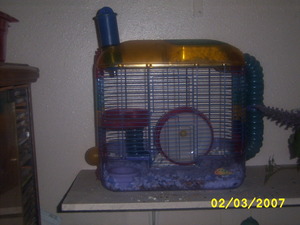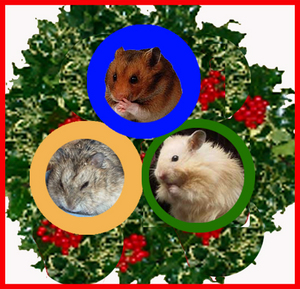Owning a pet takes a strong sense of responsibility, dedication, and a loving touch. I recently purchased a Teddy Bear Hamster for my 2 year old son. Of course, my son is too small for this type of responsibility so I take care of the hamster and he helps. There are numerous types of hamsters to choose from but I find the Teddy Bear’s to be the most friendly and easiest to tame. After having 3 different hamsters over the course of my life, which all lived quite a long time, I have learned a few things about these cute tiny creatures.
Habitat
Hamsters need to have a home where they can create their own space, sleep, and eat. There are 3 main types of cages that you can purchase for a Teddy Bear Hamster. When purchasing a hamster trail, you have a plastic, usually rectangular, base that connects with various tunnels and spaces where the hamster can crawl and exercise. Another option is a metal cage that allows more air to flow through your hamster’s home. The third option that I prefer best is an aquarium. Aquariums give the hamster plenty of room to room and there is little chance that they can escape.
In your hamster’s habitat, it is important that you have all of the necessary equipment and items to keep your pet happy and healthy. There should be wood or paper bedding lined across the bottom of the hamsters cage. Hamsters like to sleep, play, and snug up in the bedding and it allows them to feel more comfortable in their home. They may decide to move the bedding around and create beds in the corner of the cage. The bedding is also used to soak up any urine and it helps to stop the smell.
Other important items that you should find in the cage are cardboard. Hamsters adore cardboard and it is necessary to have a cardboard, plastic, or wood bed in their cage for them to sleep and hide in. I used a shoe box with a small hole cut in the front to allow the hamster to enter the box. Fill the hamsters sleeping box with unscented tissues or paper towels. Your hamster will most likely rip up the paper and sleep on it.
Nutrition
Hamsters need to eat a variety of food in order to get all the nutrients needed to stay healthy. You should purchase a bag of hamster food from your local pet store that contains both seeds and dried fruits and vegetables. Avoid the hamster food that just contains seeds because this type of food does not give all the needed nutrients and can cause your hamster to become overweight.
Along with the store purchased food, you can also feed your hamster fresh fruits and vegetables. You should only feed them about ½ of a teaspoon of a new fruit or vegetable once a week. Check often to see if the food is given them any digestive problems. Try a new fruit or vegetable each week to see which they like better. Only leave the fruit and vegetable in the cage for a maximum of ½ hour. Leaving it in the cage after that can cause the hamster to become sick. Always leave a bowl of regular hamster food in the cage for your hamster to eat whenever they get hungry. Always leave a water bottle in the cage with fresh water.
Foods to Feed a Hamster:
Cucumbers
Carrots
Apples
Bananas
Lettuce
Grapes
Broccoli
Cashews
Corn
Chestnuts
Cottage Cheese
Alfalfa
Cheerios
Dog Biscuits
Foods NOT to Feed a Hamster:
Almonds
Apple Seeds
Citrus Fruits
Cabbage
Kidney Beans
Pickles
Mushrooms
Potatoes
Tomatoes
Onions
Eggplant
Garlic
Do not feed your hamster too much of these types of food because it can cause liver and other problems if given constantly. All foods should be given at room temperature and be free of oils, seasonings, and spices. Hamsters are also able to eat some live foods such as crickets. These foods should also only be given once or twice a week.
Taming
When you first bring your new hamster home, they may be very scared, hiss, and even bite if you try to touch them. Allow your new pet to get accustomed to their new home for about one or two weeks before attempting to put your hand near them. When you feel that your hamster is ready for the next step, slowly put your hand to the bottom of the cage and allow the hamster to come and sniff your hand. When they walk away, take your hand out of the cage and walk away. Repeat this a few times to let your hamster get used to your smell. Once they become used to your hand being in the cage, you can try to pick them up.
Gently pet their heads and back. Once they know that you are not going to harm them, they will not fear you and allow you to pick them up and touch them without a problem. This could take months but do not get stressed and remember that it will com in time.
Conclusion
Hamsters can be great pets, especially for younger children who are looking for a small responsibility. Always help younger kids take care of their new Teddy Bear Hamster and let them enjoy watching their pet in a round rolling ball or on their wheel. This can be a great experience for young children to learn responsibility and how to treat another living creature.
Source: http://allaboutteddybearhamsters.blogspot.com/






